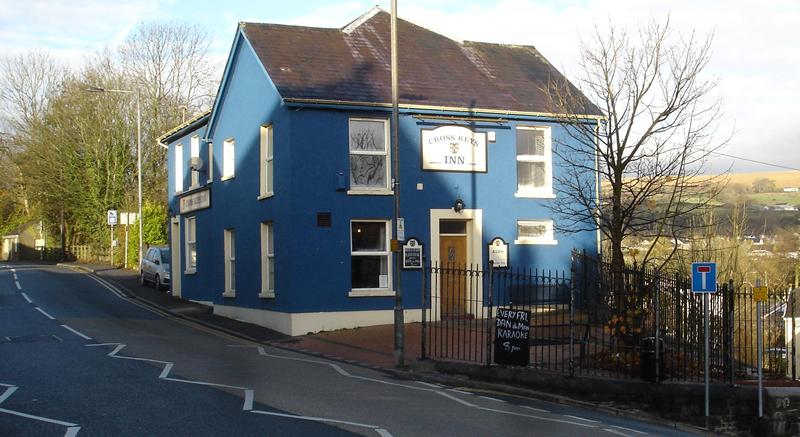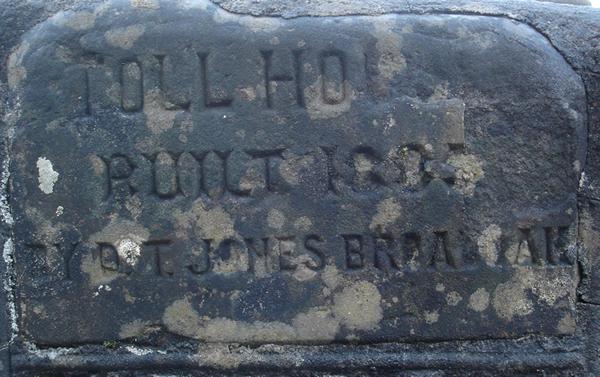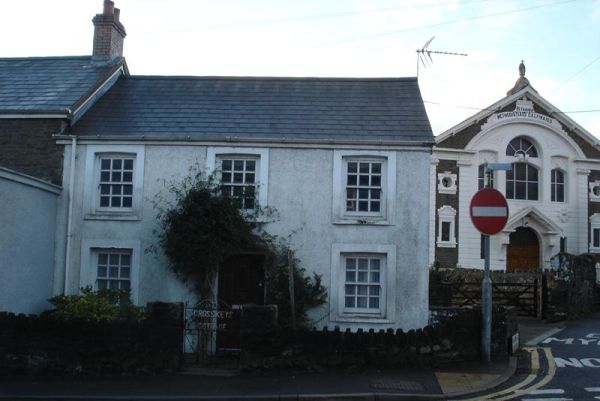Some Captured History of Glanamman and GarnantThe Cross Keys Inn and the Brynlloi Toll HouseThe highway running alongside the Cross Keys Inn was once a turnpike road, which was constructed in 1817. A small toll house stood attached to the main building of the Cross Keys Inn, accompanied by a toll gate and it is not unreasonable to assume that this had a bearing on how the Inn was named. The Wikipedia website explains that "Cross Keys" signifies the sign of St Peter, the gatekeeper of heaven. Whether the gatekeeper at Glanamman Square or "Sgwar y Gat" ("Gate Square") as it was once known, held the keys to heaven is debateable, but there was certainly a piety among the local people of the time. It is not clear when the toll gate was removed or when the original toll house was demolished, but it is not shown on an ordnance survey map dated 1891, although the Cross Keys Public House is marked. On the opposite side of the main highway is a small dwelling named "Cross Keys Cottage". Built into the boundary wall of the cottage is a stone with an inscription which reads: "TOLL HOUSE Although there is little information available regarding the history of the Cross Keys Inn, we are able to learn a little about the people who resided there from old census documents and newspaper articles. At the time of the 1841 census, the Cross keys was home to a 30 year old publican named David Thomas. His wife Eliza, was of the same age and their two daughters, who are likely to have been twins were both 10 years old. There was also a 20 year old labourer named John Thomas living at the Cross Keys at that time, but whether he is related to David Thomas is not clear. The whole of the household were born in Carmarthenshire. Sadly, David died at only 40 years old and the 17th of January 1851 edition of the Cambrian newspaper contained a death notice for David Thomas of "Gwtterfawr" (original name for Brynamman), "Late of Cross Keys". He had died of consumption. There is no reference to the Brynlloi Toll House, Gate House or Toll Collector on the 1841 census. A publication entitled "Rebecca and Her Daughters" by Henry Tobit Evans J. P. was published in 1910 and revealed that attached to the main turnpike gate was a side gate which was used by those travelling on foot. We also learn that on the 17th of April 1844, the side gate was completely destroyed by a gang known as the Merched Beca or Rebecca's Daughters. The Rebecca Riots took place throughout South and Mid Wales between 1839 and 1843 as a protest against toll charges. The Wikipedia website gives an interesting overview of the background and ceremony of the Rebecca's who reputedly dressed in womens clothing before carrying out their protests. By the time of the next census in 1851, the landlord of the Cross Keys was 50 year old William Griffiths who was originally from Llanfynydd, Carmarthenshire. As well as being a Beer House Keeper, William was also working as an agricultural labourer. William's wife was 41 year old Margaret Griffiths. The couple had four sons aged between 4 and 15 years of age as well as two daughters aged between 2 and 8 living at home. There was also a 16 year old female house servant named Elizabeth Nicholas living at the Cross keys at that time. The "Old Gate House" was occupied by a widow and her son in 1851. Rachel Thomas was 34 years old and worked as a charwoman who also knitted clothes to make a living for herself and her 9 year old son, William. Both were local people, having been born at Betws Parish. Again, there is no reference on the census for a Toll Collector. The Cross Keys had changed hands again by 1861 and the residents were 24 year old Watkin Williams and his wife Mary. Both were 24 years old and from Llanguicke Parish. Watkin's occupation was recorded as "Coal Miner" and Mary's as "Coal Miner's Wife". There was no mention of either being a publican, which raises the question of whether the Cross Keys was trading as a public house or whether the census taker merely failed to record the full details. The 1861 census also recorded that there was a Toll Collector living at "Turnpike Toll House". He was 56 year old Morgan Thomas, originally from Llandilofawr Parish and he shared the dwelling with his 63 year old wife Elizabeth, of Llangadock, Carmarthenshire. David Jones and his wife Mary, both aged 34, were the residents of the Cross Keys in 1871. Neither were recorded on the census as publicans, David Jones' occupation being recorded as Collier at that time. The couple remained at the Cross Keys until at least 1881, when David Jones was recorded as "Innkeeper and Coal Miner" on that year's census. By then, David and Mary had five sons, aged betwen 7 and 18 years of age and three daughters, aged between 3 and 12 living with them. There was also a 20 year old Domestic Servant named Anne Morgans living at the public house. David was originally from Llanguicke Parish, while his wife Mary was from Llanon. When the family vacated the Cross Keys public house, they moved to another property which was in the immediate vicinity of the hostelry. Their new abode was known as "Danceidrim". David Jones was later to become a colliery owner, reputedly opening the Cawdor Colliery and Cwmtrupit Colliery at Garnant. The Toll Collector living at "Turnpike House" in 1871 was 24 year old Anne Evans who had originally come from Blaenporth in Ceredigion. There is no reference to a Toll Collector on the 1881 census, but "Cross Keys Cottage" was occupied by a 27 year old tinplate workman named Thomas Thomas and his family, which included two children aged between 5 months and 2 years of age. Thomas was born in Llanelly, while his wife appears to have come from Monmouthshire. The children had both been born at Llanedy, Carmarthenshire, indicating that the family had relocated to Cwmamman sometime during the previous five months, almost certainly to enable Thomas to find employment in the tinplate industry. By the time of the 1891 census, 32 year old Aaron Williams was the Innkeeper of the Cross Keys. He and his wife Ann were both natives of Glanamman and remained at the Inn until at least 1901, when they were again recorded on the census as living there. At that time, Aaron's 15 year old niece Annie was living with him, but with no occupation recorded for her. There was also a 14 year old female domestic servant living at what was then the "Cross Keys Hotel". Kelly's Directory listed David Rees as the proprietor at the Cross Keys Public House in it's 1910 and 1923 editions. David's wife, Mary Hannah, was the daughter of David Jones who ran the Inn before Aaron Williams. David and Mary Hannah Rees had spent some time living in the USA before returning to Glanamman. The 1891 census made no reference to a "Toll House" or "Toll Collector" and we are therefore left to speculate as to which property it was on the census taker's list. At the "Old Cross Keys" in 1891, were 28 year old Richard Williams, who was a general labourer; his brother William Williams, aged 24, who was a coal miner and their younger sister, 23 year old Annie Williams who was their house keeper. The three had originally come from Llandybie. Some further investigation suggests that they were not siblings of Aaron Williams, the Innkeeper. It is worth noting that another property in the immediate vicinity was listed merely as "Nr Gate". It is therefore not absolutely certain which property was the Toll House. The "Nr Gate" dwelling was home to a 28 year old Railway Road* Layer (*occupation stated on doc was not completely legible), named David Rowlands and his wife. There was also a lodger living with them who was working as an Annealer at the tin works. With regards to the information on the 1901 census, there is again room for uncertainty. There is no reference to a Toll Collector and it is likely that the tolls had been abolished by that time. There is however an entry for "Toll House" and this was home to an 88 year old widow named Ann Jones. Ann had retired and an interesting observation is that like many others in the Amman Valley at that time, she spoke only Welsh. Other entries on the 1901 census include "Old Cross Keys Cottage", where William Williams continued to reside with his sister (although their elder brother was no longer listed there). This may suggest that the "Nr Gate" entry on the 1891 census was the Toll House. Ther was also an entry for "Cross Keys Cottage" in the immediate vicinity, where David Jones (former Innkeeper of the Cross keys and Danceidrim) was now resident. Although it is uncertain when the original Toll House was demolished, it is most likely that the home of David Jones in 1901 was the "Cross Keys Cottage" pictured below, which as stated at the top of this page is on the opposite side of the main highway to the Cross Keys Hotel (see image of stone). An image of the Cross Keys Inn and Brynlloi Toll House
at the end of the 19th Century can be seen in a book entitled "Dyffryn
Aman 'Slawer Dydd" by David A. Evans and Huw Walters. Sadly it
is out of print but copies are available from libraries in the Amman
Valley. |


